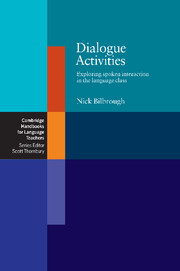Book contents
- Frontmatter
- Contents
- Thanks and acknowledgements
- Introduction
- 1 Understanding
- 2 Analysing
- 3 Reproducing and reconstructing
- 4 Memorising
- 5 Rehearsing and performing
- 6 Co-constructing
- 7 Creating and personalising
- 8 Communicating
- 9 Dialogue as learning
- Dialogue Bank A From the film Mulholland Drive
- Dialogue Bank B Authentic snippets
- Dialogue Bank C Snippets from fairy tales
- Dialogue Bank D Lame jokes
- Dialogue Bank E Situational dialogues
- Dialogue Bank F ‘Dating Agency’ from the comedy series Little Britain
- Further reading and resources
- Index
3 - Reproducing and reconstructing
Published online by Cambridge University Press: 06 July 2010
- Frontmatter
- Contents
- Thanks and acknowledgements
- Introduction
- 1 Understanding
- 2 Analysing
- 3 Reproducing and reconstructing
- 4 Memorising
- 5 Rehearsing and performing
- 6 Co-constructing
- 7 Creating and personalising
- 8 Communicating
- 9 Dialogue as learning
- Dialogue Bank A From the film Mulholland Drive
- Dialogue Bank B Authentic snippets
- Dialogue Bank C Snippets from fairy tales
- Dialogue Bank D Lame jokes
- Dialogue Bank E Situational dialogues
- Dialogue Bank F ‘Dating Agency’ from the comedy series Little Britain
- Further reading and resources
- Index
Summary
So far this book has focused on the more passive language skills of understanding and analysis. This chapter bridges the gap from the receptive use of dialogues to their productive use, and lays the foundations for dialogues as something to be practised and created. We will explore this aspect further in the chapters that follow.
One task type that bridges the receptive–productive gap is the dictogloss. A basic dictogloss procedure for reconstructing a short dialogue might be as follows:
1 The students listen to a recording of the dialogue or the teacher reads it out.
2 They discuss in pairs what they can remember about it.
3 They listen to the dialogue again and are asked to make a note of the key words used.
4 They work in pairs again, pool the words they wrote down and together write up their best version of the complete dialogue.
5 They are given a written copy of the original dialogue to compare with their own.
An activity like this is a useful one for a number of reasons. Firstly, there is a focus on listening and speaking – students need to understand the dialogue they have heard in order to talk about it or make notes on it, and if they didn't understand certain parts there is a chance that they can be helped towards understanding through discussion with a partner.
- Type
- Chapter
- Information
- Dialogue ActivitiesExploring Spoken Interaction in the Language Class, pp. 62 - 90Publisher: Cambridge University PressPrint publication year: 2007

